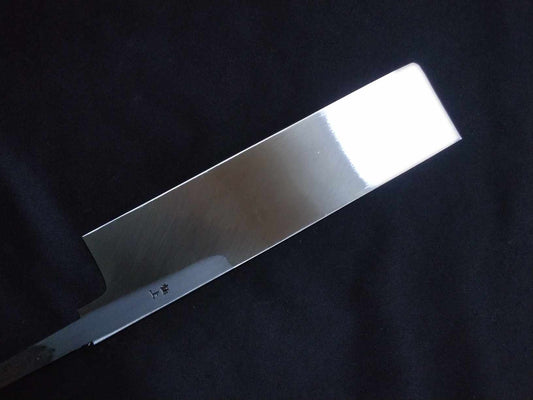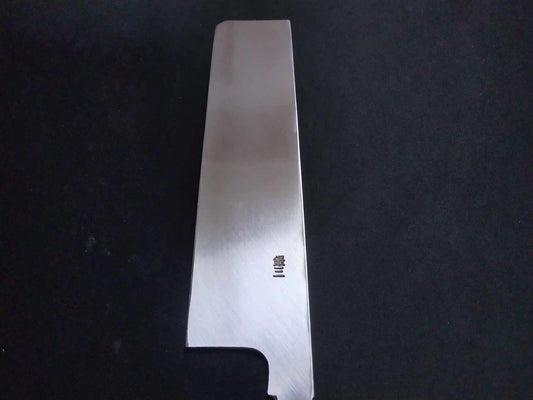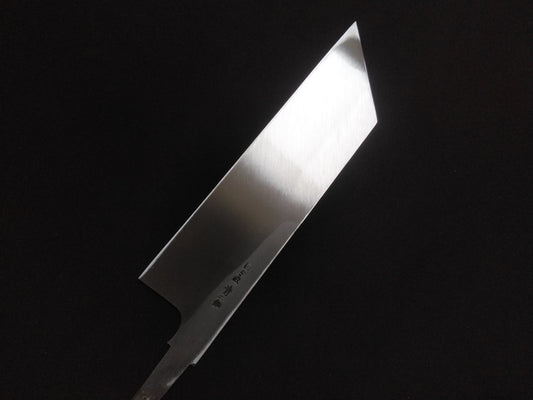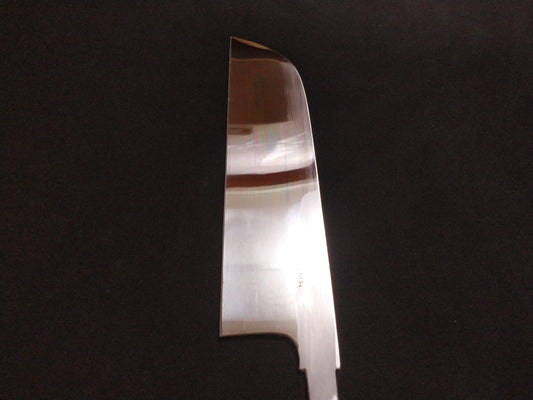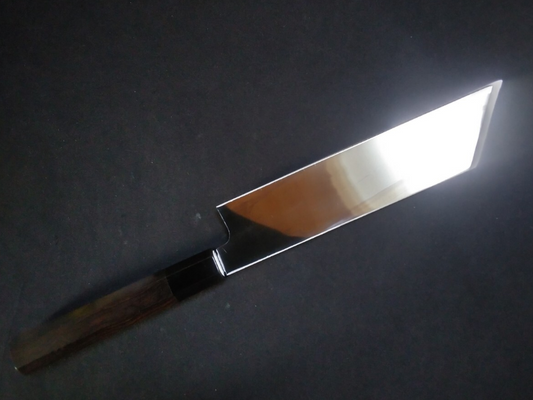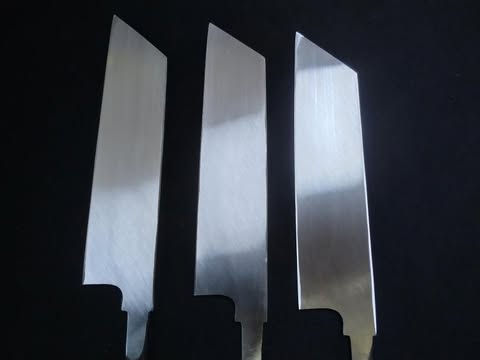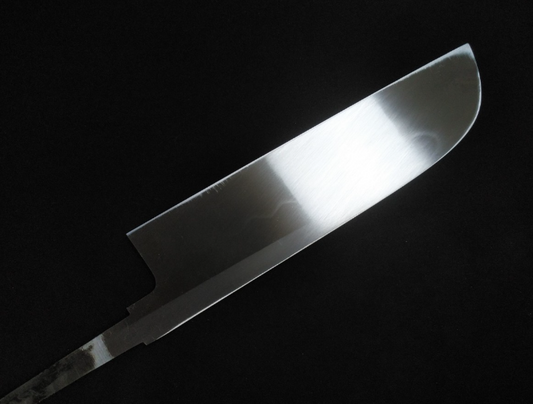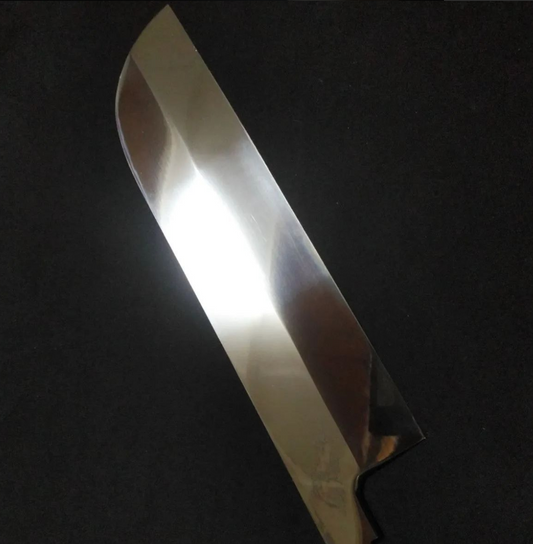
Usuba
-
Colonne
Trois lames. Trois traditions. De la précision de l'Usuba à la polyvalence du Kamausuba, en passant par la délicatesse du Mukimono, chaque coupe révèle la beauté cachée de chaque ingrédient.
-
Collection de couteaux japonais Usuba
-
Super acier (Honyaki) Deba 210mm-poli miroir (des deux côtés)
Prix habituel $346.00 CADPrix habituelPrix unitaire / par$334.00 CADPrix promotionnel $346.00 CADÉpuisé -
Acier Damas Ginsan Yanagiba (Kiritsuke) 270mm - Poli miroir (des deux côtés)
Prix habituel $412.00 CADPrix habituelPrix unitaire / par$0.00 CADPrix promotionnel $412.00 CADÉpuisé -
Acier bleu #2 Mukimono 190 mm - Poli miroir (un côté)
Prix habituel $445.00 CADPrix habituelPrix unitaire / par$445.00 CADPrix promotionnel $445.00 CADÉpuisé -
Super acier (Honyaki) Deba 210mm-poli miroir (des deux côtés)
Prix habituel $460.00 CADPrix habituelPrix unitaire / par$460.00 CADPrix promotionnel $460.00 CADÉpuisé -
Super Acier (Honyaki) Yanagiba 240mm
Prix habituel $630.00 CADPrix habituelPrix unitaire / par$0.00 CADPrix promotionnel $630.00 CAD -
Super Acier (Honyaki) Yanagiba 240mm
Prix habituel $650.00 CADPrix habituelPrix unitaire / par$0.00 CADPrix promotionnel $650.00 CAD -
Super acier (Honyaki) Deba 210mm-poli miroir (des deux côtés)
Prix habituel $850.00 CADPrix habituelPrix unitaire / par$380.00 CADPrix promotionnel $850.00 CADÉpuisé -
Super acier (Honyaki) Deba 210mm-poli miroir (des deux côtés)
Prix habituel $900.00 CADPrix habituelPrix unitaire / par$380.00 CADPrix promotionnel $900.00 CADÉpuisé -
Super acier (Honyaki) Deba 210mm-poli miroir (des deux côtés)
Prix habituel $930.00 CADPrix habituelPrix unitaire / par$380.00 CADPrix promotionnel $930.00 CAD -
Super Acier (Honyaki) Yanagiba 240mm
Prix habituel $960.00 CADPrix habituelPrix unitaire / par$0.00 CADPrix promotionnel $960.00 CAD
Les trois promesses de KIREAJI
-

1. Forgé dans l'héritage de Sakai
Originaire de Sakai, berceau japonais des couteaux de cuisine professionnels, chaque lame est fabriquée par des maîtres artisans forts de plus de six siècles de tradition. Parfaitement équilibrée, durablement tranchante et d'une finition exquise, chaque coupe incarne l'essence même du savoir-faire artisanal.
-

2. Un soin attentionné pour une utilisation quotidienne
Chaque couteau est livré avec un saya en magnolia monté à la main pour un rangement sécurisé. Sur demande, nous offrons un affûtage final Honbazuke gratuit, pour un tranchant précis et prêt à l'emploi dès le premier jour.
-

3. Un partenariat pour la vie
Un couteau KIREAJI est plus qu'un outil : c'est un compagnon de vie. Grâce à nos services d'entretien sur mesure et payants, nous préservons son tranchant et sa beauté, garantissant qu'il reste aussi précis et fiable qu'au premier jour.
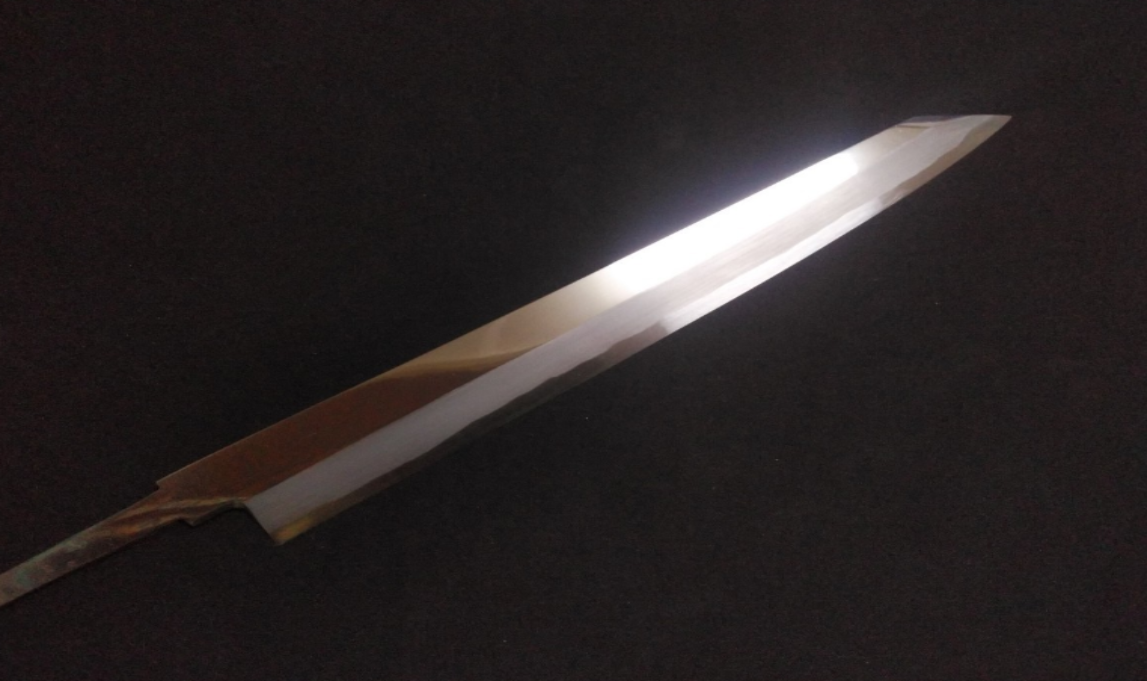
Pourquoi de nombreuses photos de produits ne montrent que la lame
Chez KIREAJI, chaque couteau est fabriqué sur commande à Sakai, au Japon. Les photos montrent la lame avant la fixation du manche, ce qui permet aux artisans de peaufiner l'équilibre et le tranchant pour votre commande. Votre couteau vous est livré entièrement fini, taillé sur mesure, spécialement pour vous.

Livraison mondiale depuis Sakai
Partout dans le monde, les cuisiniers exigeants recherchent des couteaux japonais authentiques de Sakai, la légendaire ville japonaise de fabrication de couteaux avec plus de 600 ans de tradition.
Chez KIREAJI, nous travaillons aux côtés de maîtres artisans de Sakai pour répondre à ce désir, en expédiant de véritables couteaux fabriqués à la main directement de l'atelier aux cuisines du monde entier.
-
Usuba
-
Les couteaux Usuba sont disponibles en plusieurs types, chacun étant adapté à des tâches spécifiques. Nous allons ici aborder trois principaux types de couteaux Usuba et leurs caractéristiques uniques.
-
1. Usuba
-

L'Usuba est un couteau japonais traditionnel principalement utilisé dans la région de Kanto et est particulièrement adapté aux tâches de coupe. Voici un aperçu de ses principales caractéristiques et des utilisations recommandées :
-
Caractéristiques principales
Lame rectangulaire : L'Usuba est dotée d'une lame rectangulaire , qui permet une répartition du poids vers l'avant . Cette conception facilite le travail sur la planche à découper , permettant des coupes lisses et stables.
-
Avantages
Répartition du poids vers l'avant : La lame rectangulaire avec répartition du poids vers l'avant améliore l'efficacité de la planche à découper, rendant les tâches de coupe répétitives et le travail détaillé plus confortables et moins fatigants.
-
2. Kamausuba
-

Le Kamausuba est un couteau polyvalent qui est devenu populaire ces derniers temps. Ce type de couteau est conçu pour gérer à la fois les tâches de coupe et les tâches d'épluchage , ce qui le rend utile pour une large gamme d'applications. La conception en forme de kama lui permet d'exceller dans les deux rôles, ce qui en fait un outil incontournable pour de nombreux chefs.
-
Caractéristiques principales
- Design Kansai : Le Kamausuba est connu pour son design de style Kansai et est traditionnellement utilisé dans la région du Kansai au Japon. Récemment, ce type de couteau est devenu courant.
- Combinaison d'avantages : Ce couteau combine les avantages des couteaux Usuba et Mukimono . Plus précisément, il allie les avantages de la lame fine des couteaux Usuba à la précision des couteaux Mukimono.
- Pointe acérée : Contrairement aux couteaux Usuba à pointe arrondie, le Kamausuba présente une pointe acérée , permettant des coupes précises et un travail détaillé .
-
Avantages
- Polyvalence : Le Kamausuba intègre l'avantage de la lame fine des couteaux Usuba et la précision de la pointe acérée des couteaux Mukimono, ce qui le rend adapté à diverses tâches de coupe .
- Efficacité de coupe améliorée : le Kamausuba est plus lourd que les couteaux Mukimono, ce qui améliore son efficacité dans les tâches de coupe . Cela se traduit par une efficacité de cuisson améliorée et une préparation quotidienne des repas plus fluide.
- Facilité de travail fin : Le Kamausuba excelle dans les coupes fines et les tâches détaillées . Sa combinaison d' épaisseur et de résistance en fait un couteau polyvalent et convivial .
-
Dans l'ensemble, le couteau Kamausuba combine les meilleures caractéristiques des couteaux Usuba et Mukimono , offrant polyvalence et facilité d'utilisation . Sa pointe acérée et son efficacité de coupe améliorée le rendent adapté à une large gamme de tâches de cuisine, de la préparation quotidienne des repas aux travaux de découpe détaillés.
-
3. Mukimono
-

Les couteaux Mukimono , également appelés couteaux à éplucher , sont conçus spécifiquement pour les tâches de coupe complexes. Voici un aperçu détaillé de leurs caractéristiques et avantages :
-
Caractéristiques principales
- Lame étroite : Les Mukimono ont une lame très étroite , idéale pour les travaux de précision. Cette lame fine permet une manœuvre facile et une coupe délicate , particulièrement utile pour des tâches telles que l'épluchage et la préparation complexe des légumes .
- Finesse : La lame d'un couteau Mukimono est non seulement étroite mais également fine , ce qui la rend tranchante et précise . Cette finesse est avantageuse pour effectuer des coupes fines telles que le katsura-muki (épluchage de légumes en fines lanières ressemblant à des rubans). La lame fine garantit que même les tâches les plus délicates sont traitées avec facilité.
- Pointe acérée : L'une des caractéristiques les plus distinctives du couteau Mukimono est sa pointe extrêmement acérée . Ce tranchant est essentiel pour les travaux de précision , tels que la découpe décorative ou les détails fins dans les plats de présentation. La pointe précise permet un contrôle précis , ce qui permet de voir et de gérer plus facilement l'endroit exact où la coupe est effectuée.
-
Avantages
- Précision améliorée : la largeur étroite et la lame fine rendent les couteaux Mukimono particulièrement adaptés aux tâches de précision. La finesse de la lame permet d'effectuer des coupes complexes avec un minimum d'effort, ce qui la rend parfaite pour des tâches telles que les garnitures décoratives et l'épluchage détaillé .
- Facilité d'utilisation : Grâce au tranchant et à la finesse de la lame, les couteaux Mukimono offrent une maniabilité et un contrôle supérieurs . La lame étroite permet des réglages précis lors de la coupe, ce qui est particulièrement bénéfique pour les tâches nécessitant un toucher délicat .
- Polyvalence dans le travail de détail : La pointe acérée et la lame fine du couteau Mukimono le rendent très efficace pour créer des motifs complexes ou réaliser des travaux de précision , tels que la sculpture de fruits et de légumes . Cela en fait un outil essentiel pour les chefs et les cuisiniers amateurs qui souhaitent ajouter une touche artistique à leurs plats.
-
En résumé, les couteaux Mukimono sont des outils spécialisés conçus pour la précision et le détail . Leur largeur étroite , leur lame fine et leur pointe acérée les rendent idéaux pour les tâches complexes comme l'épluchage et la découpe décorative , offrant un contrôle et une précision exceptionnels dans les travaux culinaires détaillés.
-
Alors que nous entrons dans le monde d'Usuba, où la tradition rencontre la précision, permettez-nous de vous présenter notre collection exclusive Usuba - une gamme de lames fabriquées par les artisans les plus vénérés du Japon.
Ce ne sont pas de simples outils, mais des chefs-d’œuvre nés de l’héritage, conçus pour ceux qui apprécient la qualité sans compromis et le design intemporel .
Comprendre les trois types de couteaux Usuba : des outils de précision pour maîtriser la cuisson des légumes
-

Chaque modèle de couteau Usuba offre un avantage distinct.
En choisissant le bon type, vous optimisez votre travail des légumes avec précision, contrôle et des performances adaptées à un usage spécifique . -
Vous n'êtes toujours pas sûr de choisir un Usuba ou un Nakiri ?
-
Le Nakiri et l'Usuba sont deux couteaux à légumes japonais emblématiques, mais ils répondent à des besoins, des niveaux de compétence et des styles de coupe différents. Comprendre leurs différences vous aidera à choisir un couteau qui deviendra le prolongement naturel de votre main.
-
Différences entre Nakiri et Usuba
- Lame à double biseau , affûtée des deux côtés pour plus de polyvalence.
- Son profil rectangulaire le rend parfait pour hacher, trancher et émincer les légumes.
- Privilégié dans les cuisines domestiques pour sa facilité d'utilisation et sa capacité à gérer une grande variété de tâches de coupe.
-

Colonne
Nakiri
Le couteau Nakiri est spécialement conçu pour les légumes . Il est doté d'une lame rectangulaire particulièrement efficace pour couper les légumes et les émincer . La lame du couteau Nakiri est à double biseau , ce qui signifie qu'elle est affûtée des deux côtés. Cette conception rend le Nakiri polyvalent et couramment utilisé dans les cuisines domestiques pour diverses tâches de coupe.
-
Principales différences
- Forme et affûtage de la lame : Le couteau Nakiri possède un double biseau et diffère des deux côtés de la lame. En revanche, le couteau Usuba possède un biseau simple (ou biseau unilatéral ), affûté d'un seul côté.
- Utilisation : Le couteau Nakiri est un outil polyvalent utilisé principalement pour couper les légumes dans les cuisines domestiques. Le couteau Usuba est conçu pour les tâches délicates et la coupe de précision , ce qui le rend idéal pour trancher le sashimi et d'autres travaux complexes.
- Précision de coupe : Le couteau Usuba offre un haut niveau de précision et est excellent pour les tâches nécessitant une coupe fine. Le couteau Nakiri est plus adapté à la préparation générale des légumes , offrant un outil pratique et efficace pour une utilisation quotidienne.
-

-
Le couteau Nakiri est un outil polyvalent parfait pour la préparation quotidienne des légumes en cuisine. En revanche, le couteau Usuba excelle dans les tâches de précision et les besoins de coupe spécialisés, comme le tranchage du sashimi . Comprendre les caractéristiques et les utilisations de chaque couteau permet un travail de cuisine plus efficace et plus efficient.
Choisir entre Nakiri et Usuba : facilité d’utilisation ou précision ?
-

Le Nakiri et l'Usuba partagent peut-être la même silhouette, mais leur esprit est radicalement différent. Le Nakiri offre une facilité d'utilisation au quotidien , avec un double biseau qui convient à tous les cuisiniers amateurs. L'Usuba, en revanche, est un outil exigeant une grande rigueur et une précision extrême, conçu pour les chefs qui privilégient les coupes ultra-fines et la maîtrise des techniques décoratives. Choisir entre les deux, c'est choisir entre une polyvalence sans effort et une finesse digne des professionnels : deux voies pour sublimer la préparation des légumes en cuisine.
-
FAQ sur Usuba
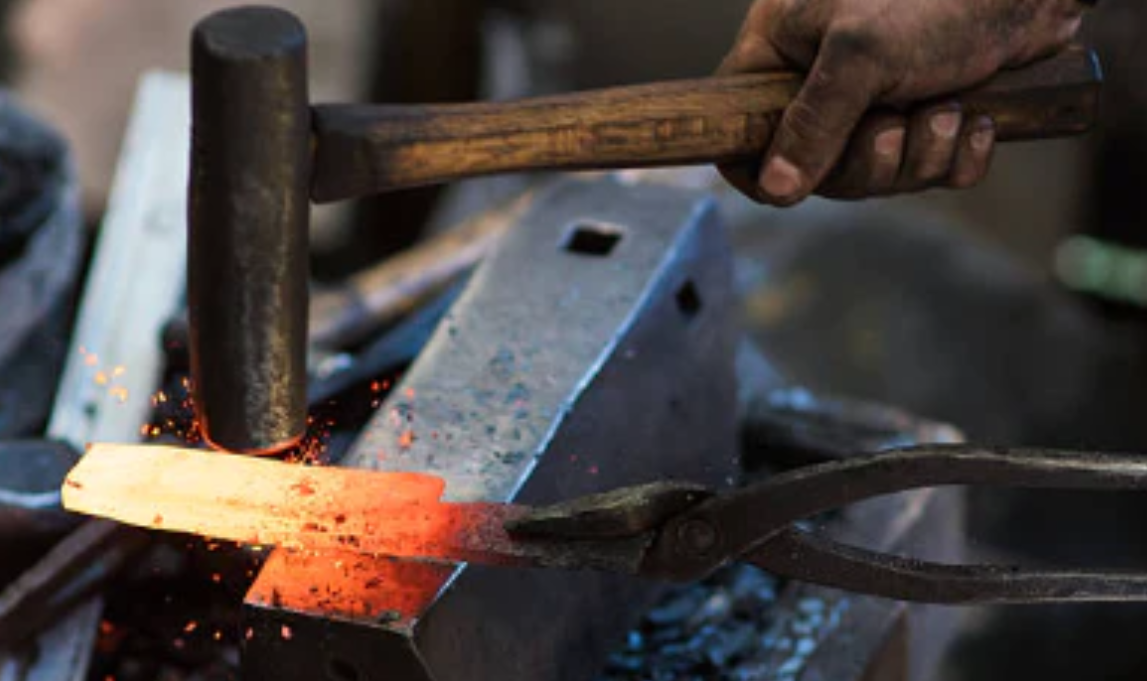
Q1. Quels sont les avantages d'un couteau Usuba ?
L'Usuba (薄刃), qui signifie « lame fine », est un couteau à légumes japonais traditionnel conçu pour la précision et la finesse. Son tranchant ultra-fin à simple biseau permet des coupes nettes et contrôlées, idéales pour les légumes délicats. Il est idéal pour les techniques spécialisées telles que le katsuramuki (épluchage rotatif), le sen-giri (coupe en julienne), le hachage fin et les coupes décoratives. Grâce à sa coupe douce et sans résistance, il réduit la fatigue de l'utilisateur tout en offrant des coupes nettes et droites qui subliment les garnitures et les plats de légumes.
Q2. À quoi sert un Usuba ?
L'Usuba est principalement utilisé pour couper, hacher et éplucher les légumes dans la cuisine japonaise. Parmi les trois couteaux traditionnels essentiels – Deba, Yanagiba et Usuba –, il est considéré comme le plus exigeant techniquement à aiguiser en raison de sa lame droite à simple biseau, exigeant précision et constance.
Q3. Quelle est la différence entre un Mukimono et un Usuba ?
Tous deux sont des couteaux à légumes à simple biseau, mais leur conception et leur fonction diffèrent. Le Mukimono, originaire de la région de Kanto, possède un dos plus fin et une pointe en forme de losange, ce qui le rend idéal pour l'épluchage décoratif et les garnitures complexes. L'Usuba, quant à lui, possède une lame plus large et plus lourde, au tranchant plat, plus adaptée aux coupes droites et nettes et au katsuramuki.
Q4. Que dois-je choisir : Nakiri ou Usuba ?
Aucun des deux n'est meilleur en soi ; tout dépend du niveau de compétence et de l'usage. L'Usuba est destiné aux professionnels et aux utilisateurs expérimentés qui exigent une précision maximale et sont à l'aise avec la manipulation et l'affûtage d'une lame à simple biseau. Le Nakiri, quant à lui, est doté d'un double biseau, plus facile à contrôler et à entretenir, et mieux adapté à la cuisine maison et à la préparation générale des légumes. Votre choix dépend de votre aisance avec les couteaux japonais traditionnels et du niveau de raffinement que vous recherchez.
Q5. Que signifie « Usuba » en japonais ?
« Usuba » s'écrit 薄刃, 薄 (usu) signifiant « fin » et 刃 (ba) signifiant « lame ». Ce nom reflète directement sa caractéristique principale : une lame fine conçue pour le travail délicat des légumes.
Q6. L'Usuba est-il difficile à maîtriser ?
Oui. Plus que la plupart des couteaux japonais, l'Usuba exige une technique précise et une pratique régulière pour être utilisé efficacement. Son tranchant fin et droit peut s'écailler en cas de mauvaise manipulation, et l'affûtage exige une précision pour maintenir un biseau parfaitement plat. Pour les chefs formés à la cuisine japonaise traditionnelle, maîtriser l'Usuba est un véritable gage de savoir-faire et d'art.
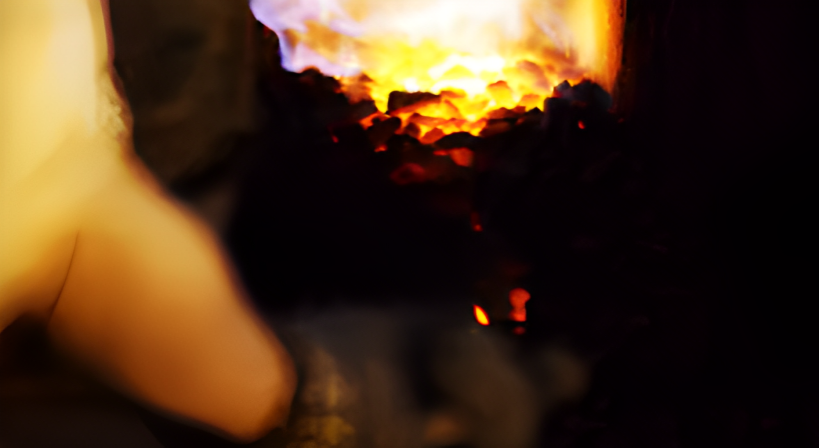
L'origine de l'artisanat
-
La vraie valeur d'un Usuba
L' usuba est un outil indispensable pour les chefs lorsqu'ils travaillent avec des ingrédients délicats. Comme son nom l'indique, sa lame fine et finement travaillée lui permet de manipuler avec soin des ingrédients fragiles comme les tomates ou le tofu, en préservant leur structure tout en créant des coupes parfaitement nettes .
-
Par exemple, pour trancher du tofu, une lame plus épaisse peut exercer une force inutile, provoquant l'effritement du bloc délicat. En revanche, avec un usuba, la lame glisse avec un minimum d'effort, garantissant que la beauté naturelle de l'ingrédient soit préservée jusque dans l'assiette.
-
Fabriquer un tel couteau ne se résume pas à rendre la lame fine. Obtenir l' équilibre parfait entre tranchant et durabilité exige une compétence et une expérience exceptionnelles. L'attrait d'un usuba réside non seulement dans sa précision délicate, mais aussi dans la maîtrise inhérente à sa création.
-
Pour ceux qui apprécient l’individualité des ingrédients et souhaitent les mettre en valeur à travers leur travail culinaire, un usuba devient un compagnon de confiance en cuisine.
Comment sont fabriqués les couteaux japonais : la tradition Sakai
VIDÉO FOURNIE : ARTISANAT TRADITIONNEL JAPONAIS PLACE AOYAMA (YOUTUBE)
-
Lames forgées Sakai — Six siècles de savoir-faire inégalé
Appréciés par les chefs du monde entier et approuvés par 98 % des meilleurs professionnels de la cuisine japonaise , les couteaux Sakai sont plus que des outils : ils sont l'héritage vivant de plus de 600 ans de savoir-faire artisanal .
-
Chez KIREAJI, nous travaillons directement avec l' atelier de couteaux Shiroyama de Sakai, au Japon, garantissant que chaque lame est forgée à la main, finie à la perfection et expédiée directement de l'atelier aux cuisines du monde entier. Pas d'intermédiaire. Pas de production de masse. Uniquement des couteaux authentiques, fabriqués artisanalement , conçus pour sublimer votre cuisine tout au long de votre vie.


